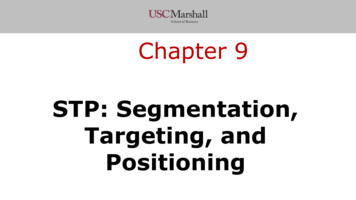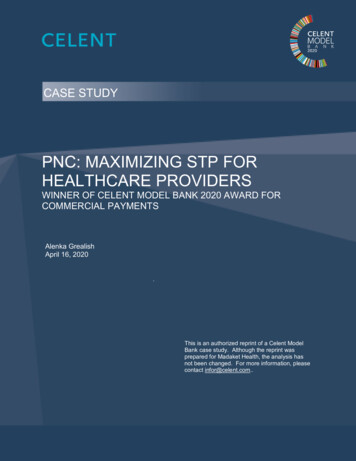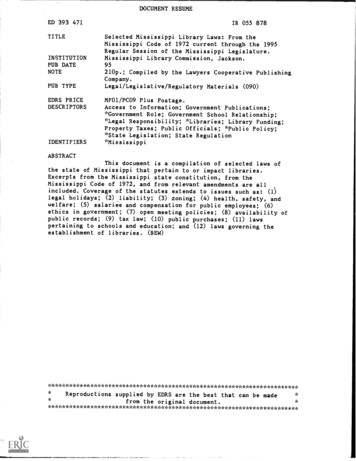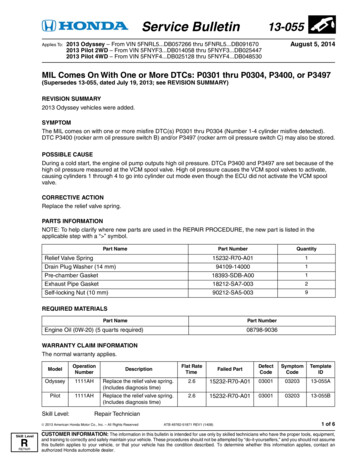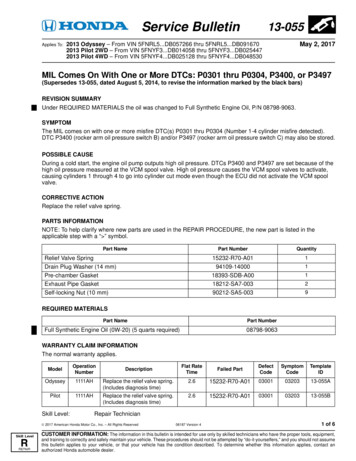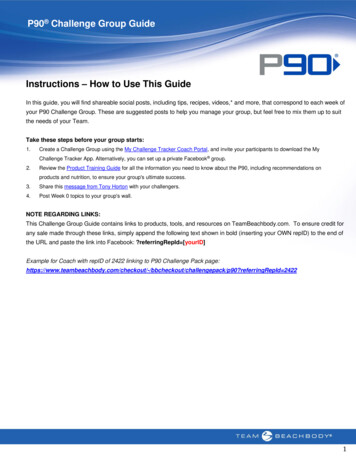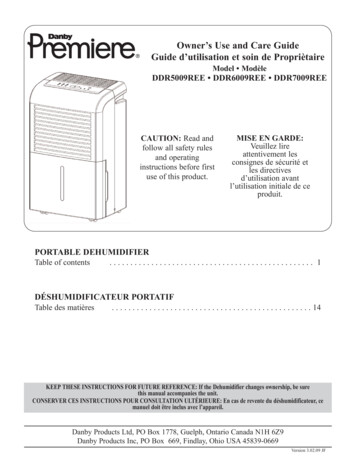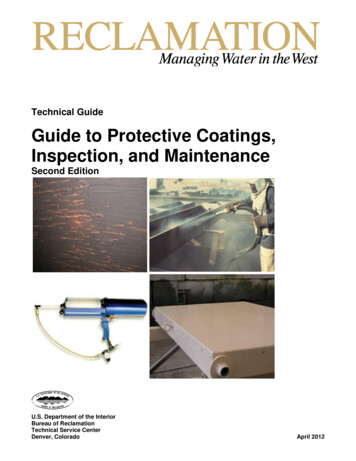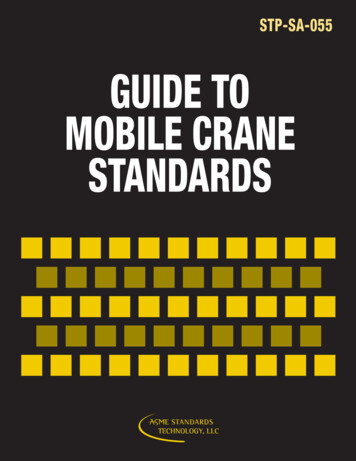
Transcription
STP-SA-055GUIDE TOMOBILE CRANESTANDARDS
STP-SA-055GUIDE TOMOBILE CRANESTANDARDSPrepared by:Dennis EckstineEckstine and Associates, Inc.
Date of Issuance: December 21, 2012This report was prepared as an account of work sponsored by ASME Safety Codes and Standards and theASME Standards Technology, LLC (ASME ST-LLC).Neither ASME, ASME ST-LLC, the author, nor others involved in the preparation or review of this report,nor any of their respective employees, members or persons acting on their behalf, makes any warranty, expressor implied, or assumes any legal liability or responsibility for the accuracy, completeness or usefulness of anyinformation, apparatus, product or process disclosed, or represents that its use would not infringe upon privatelyowned rights.Reference herein to any specific commercial product, process or service by trade name, trademark,manufacturer or otherwise does not necessarily constitute or imply its endorsement, recommendation orfavoring by ASME ST-LLC or others involved in the preparation or review of this report, or any agencythereof. The views and opinions of the authors, contributors and reviewers of the report expressed herein do notnecessarily reflect those of ASME ST-LLC or others involved in the preparation or review of this report, or anyagency thereof.ASME ST-LLC does not take any position with respect to the validity of any patent rights asserted inconnection with any items mentioned in this document, and does not undertake to insure anyone utilizing apublication against liability for infringement of any applicable Letters Patent, nor assumes any such liability.Users of a publication are expressly advised that determination of the validity of any such patent rights, and therisk of infringement of such rights, is entirely their own responsibility.Participation by federal agency representative(s) or person(s) affiliated with industry is not to be interpretedas government or industry endorsement of this publication.ASME is the registered trademark of the American Society of Mechanical Engineers.No part of this document may be reproduced in any form,in an electronic retrieval system or otherwise,without the prior written permission of the publisher.ASME Standards Technology, LLCThree Park Avenue, New York, NY 10016-5990ISBN No. 978-0-7918-6867-6Copyright 2012 byASME Standards Technology, LLCAll Rights Reserved
Guide to Mobile Crane StandardsSTP-SA-055TABLE OF CONTENTSForeword . vAbstract . vi1INTRODUCTION . 12U. S. FEDERAL GOVERNMENT DOCUMENTS . 22.1 Occupational Safety and Health Act (OSHA) . 22.1.1 OSHA 29 CFR Part 1910.180 Crawler and Locomotive Truck Cranes in GeneralIndustry . 22.1.2 OSHA 29 CFR Part 1926.1400 Subpart CC – Cranes and Derricks in Construction . 22.1.3 OSHA 29 CFR Part 1915 – Shipyard Employment - Subpart G - Gear andEquipment for Rigging and Materials Handling . 22.1.4 OSHA 29 CFR Part 1915 – Shipyard Employment – Part 1915.136 – Internalcombustion engines, other than ship’s equipment . 32.1.5 OSHA 29 CFR Part 1917 - Maritime Terminals – Subpart C – Cargo HandlingGear and Equipment . 32.1.6 OSHA 29 CFR Part 1918 – Safety and Health Regulations for Longshoring Subpart G – Cargo Handling Gear and Equipment Other Than Ship’s Gear . 32.2 Safety and Health Requirements Manual, EM 385-1-1, U.S. Army Corps of Engineers,(USACOE) Department of the Army . 32.3 Management of Weight Handling Equipment, NAVFAC P-307 . 32.4 Department of Energy (DOE) Hoisting and Rigging Standard, DOE-STD-1090-2011,Section 8, Mobile Cranes . 33STATE AND LOCAL LAW . 43.1 State Laws . 43.2 Local Laws . 54INDUSTRY AND NATIONAL CONSENSUS STANDARDS . 64.1 American National Standards . 64.1.1 A1264.1-2007 Safety Requirements for Workplace Walking/Working Surfaces andTheir Access: Workplace, Floor, Wall, Roof Openings; Stairs and GuardrailSystems. 64.1.2 ANSI A14.3 Safety Requirements for Fixed Ladder . 64.1.3 ANSI B15.1 Safety Standard for Mechanical Power Transmission Apparatus . 64.1.4 ANSI C2 National Electrical Safety Code . 64.2 American Society of Mechanical Engineers (ASME) . 64.2.1 ASME B30.5: Mobile and Locomotive Cranes . 74.2.2 ASME B30.8: Floating Cranes and Floating Derricks . 74.2.3 ASME B30.9: Slings . 74.2.4 ASME B30.10: Hooks. 74.2.5 ASME B30.14: Side Boom Tractors . 74.2.6 ASME B30.15: Mobile Hydraulic Cranes. 74.2.7 ASME B30.20: Below-the-Hook Lifting Devices . 74.2.8 ASME B30.22: Articulating Boom Cranes . 84.2.9 ASME B30.23: Personnel Lifting Systems . 84.2.10 ASME B30.25: Scrap and Material Handlers . 84.2.11 ASME B30.26: Rigging Hardware . 8iii
STP-SA-0554.34.44.54.6Guide to Mobile Crane Standards4.2.12 ANSI B30.29: Self-Erect Tower Cranes . 8American Society of Safety Engineers . 94.3.1 ANSI A10.28: Work Platforms Suspended from Cranes or Derricks . 94.3.2 ANSI A10.18: Floor and Wall Openings, Railings and Toeboards . 9ANSI/AWS American Welding Society . 94.4.1 D14.1: Specification for Welding of Industrial and Mill Cranes and Other MaterialHandling Equipment . 94.4.2 ANSI/AWS D1.1: Structural Welding Code-Steel . 9Society of Automotive Engineers (SAE), Technical Standards. 9National Electrical Code (NFPA 70) . 105INTERNATIONAL STANDARDS . 115.1 Canadian Standards Association . 115.1.1 CSA Z150 - Safety Code on Mobile Cranes . 115.1.2 CSA Z150.3 - Safety Code on Articulating Boom Cranes . 115.2 European Standards - European Committee for Standardization (CEN) . 115.2.1 EN12999: Cranes - Loader Cranes . 115.2.2 EN13000: Cranes - Mobile Cranes . 115.3 Additional International Standards . 125.3.1 British Standards Institution (BSI). 125.3.2 German Institute for Standardization (Deutsches Institut fur Normung) . 125.3.3 Australian Standards (AS) . 135.4 International Organization for Standardization (ISO). 136INDUSTRY GUIDELINES AND ADDITIONAL CORPORATE REQUIREMENTS . 156.1 American Society of Civil Engineers Manuals and Reports . 156.2 Power Crane and Shovel Association (PCSA) . 156.3 AEM Crane Safety Manual . 156.4 Additional Requirements . 157CERTIFICATIONS. 167.1 OSHA Crane Operator Certification . 167.2 Crane Operator Licensing and Certification Requirements . 16References . 17Acknowledgments. 20iv
Guide to Mobile Crane StandardsSTP-SA-055FOREWORDNumerous standards applicable to the design and manufacturing of mobile cranes exist in the UnitedStates. Heretofore there have been no published guidance criteria to assist the prospectivemanufacturer, owner or user of mobile cranes in determining which standards should be invoked for aparticular application or facility. ASME Standards Technology, LLC (ASME ST-LLC) produced thisguide to mobile crane standards to provide some guidance.“Guide to Mobile Crane Standards” considers the equipment covered by the following ASME B30Volumes: B30.5 Mobile and Locomotive Cranes, B30.8 Floating Cranes and Floating Derricks),B30.14 Side Boom Tractors, B30.22 Articulating Boom Cranes, B30.25 Scrap and Material Handlers,B30.29 Self-Erect Tower Cranes, and related equipment. This guide will provide a starting point forthe listing of the relevant standards, codes, regulations and guidelines impacting the construction,characteristics, design, inspection, testing, maintenance, operation and safe use of mobile cranes. Itwill focus on North America but will be global in its scope including the listing of ISO and significantinternational standards addressing mobile cranes. The prospective owner and user of cranes mustcomply with all federal, state and local requirements including but not limited to the ones listed in thisdocument.Established in 1880, the American Society of Mechanical Engineers (ASME) is a professional notfor-profit organization with more than 127,000 members promoting the art, science and practice ofmechanical and multidisciplinary engineering and allied sciences. ASME develops codes andstandards that enhance public safety, and provides lifelong learning and technical exchangeopportunities benefiting the engineering and technology community. ANSI does not itself writestandards, but does certify Standards Developing Organizations that meet the due processrequirements of the American National Standards Institute (ANSI). Standards that are developedunder an accredited program may be designated as American National Standards. Visitwww.asme.org for more information.The ASME Standards Technology, LLC (ASME ST-LLC) is a not-for-profit Limited LiabilityCompany, with ASME as the sole member, formed in 2004 to carry out work related to newlycommercialized technology. The ASME ST-LLC mission includes meeting the needs of industry andgovernment by providing new standards-related products and services, which advance the applicationof emerging and newly commercialized science and technology and providing the research andtechnology development needed to establish and maintain the technical relevance of codes andstandards. Visit www.stllc.asme.org for more information.v
STP-SA-055Guide to Mobile Crane StandardsABSTRACTThe purpose of this publication is to provide guidance the
“Guide to Mobile Crane Standards” considers the equipment covered by the following ASME B30 Volumes: B30.5 Mobile and Locomotive Cranes, B30.8 Floating Cranes and Floating Derricks), B30.14 Side Boom Tractors, B30.22 Articulating Boom Cranes, B30.25 Scrap and Material Handlers, B30.29 Self-Erect Tower Cranes, and related equipment. This .
